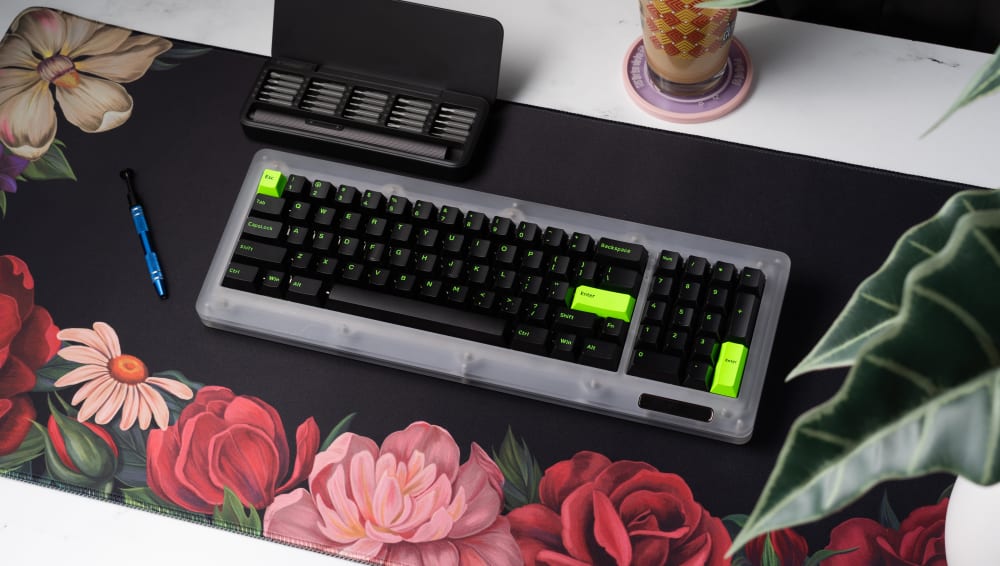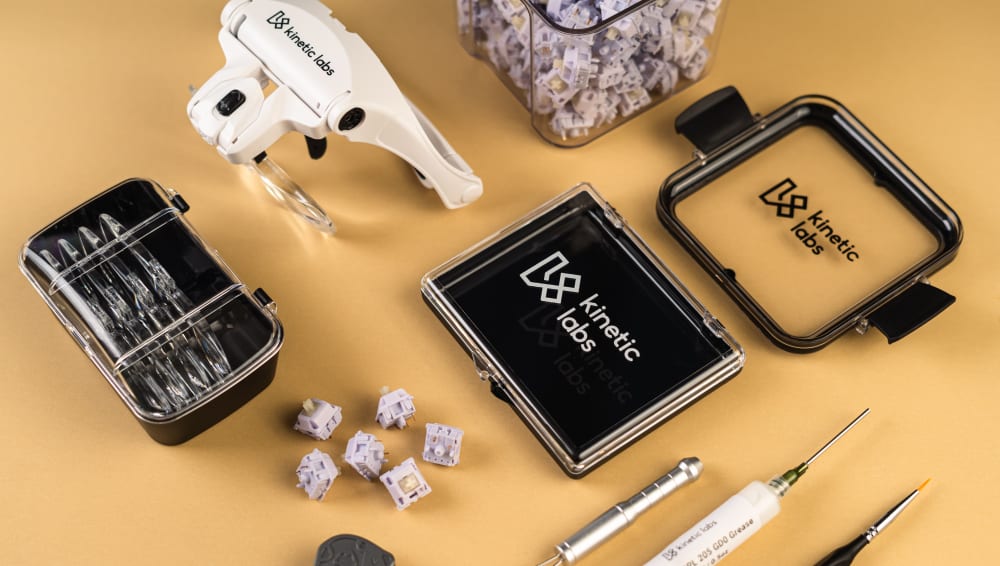Liam H.
Aug 10, 2022
•9 minutes
Mechanical Keyboard Parts List: 8 Parts for Beginners
Read this for an overview of the most common mechanical keyboard parts that you'll need to know as a beginner. We cover keyboard cases, layouts, PCBs, and more!


PolyCaps Seal V2 PBT Keycaps
Whether you’ve built your own PC or are a casual browser, mechanical keyboards come in shapes and sizes for every kind of user. As mechanical keyboards are exploding in popularity, more and more people are interested in building their own mechanical keyboards.
Sometimes, the hardest part of a project is just knowing where to start. That’s why a mechanical keyboard parts list is an essential tool for starting your building journey.
Choosing a Size
Although nearly everybody uses keyboards, they aren’t one-size-fits-all. Keyboards come in many different sizes for different needs and preferences. Some of the most common sizes are percentages: 100%, 90%, 80%, and 65%


PolyCaps Candy Shop PBT Keycaps on 65% Keyboard
The list below will help you decide which layout is right for you:
- 100%
- A 100% layout includes all 104 keys on a standard keyboard including the 10-key numpad. Non-specialty keyboards are most commonly 100% as it’s the layout most people are familiar with.
- 90%/96%/1800
- The 1800 keyboard is less common but contains most or all of the standard keys of a 100% keyboard in a more condensed form. The 90% and 96% keyboards condense the 1800 design into an even smaller footprint, frequently losing a few keys along the way, such as the lock and pause keys.
- 80%(TKL)/75%
- If the 100% keyboard is the most popular standard keyboard, an 80% keyboard is the most popular mechanical keyboard layout for users who don’t do frequent number processing. The 80% keyboard includes all of the standard keys, but without the 10-key numpad. The name “TKL” is short for “Tenkeyless” because keyboards 80% and smaller don’t include numpads. The 75% layout loses a few more keys and positions the arrow keys closer to the spacebar.
- 65% And Smaller
- The 65% is another popular mechanical keyboard size because of its compact functionality. The 65% keyboards lose the function row. Keyboards smaller than 65% (such as the 60%, 50%, and 40% sizes) usually lose some combination of the arrow keys, number row, and other function keys.
PCB and Case
Once you’ve selected the size that best suits your needs, the PCB and Case are the foundation of your keyboard. The printed circuit board (PCB) is the base of the keyboard that detects key presses and transmits data from your keys to your computer.


PC Case with PolyCaps Code Keycaps
Cases come in many different materials. The most common materials are plastic and aluminum because of their ease of manufacturing. However, other materials include wood, acrylic, or even PCB itself.
Stabilizers
The comforting click of mechanical keys is possibly the largest draw for mechanical keyboards. With the sound and feel of your keyboard being so important, rattling and wiggling are not what you want.


Durock V2 Stabilizers
Without stabilizers, larger keys act like seesaws. Stabilizers help larger keys sound and feel just as good as your standard-sized keys. I recommend Durock V2 Stabilizers for a high quality choice.
The unit of measuring keyboard size is the width of the keys, where 1u is the size of a standard key. You can buy stabilizers in sizes of 2u for larger keys (like shift or backspace) or 6.25u for the space bar. Specialty-sized keyboards may use 7u for the spacebar instead of 6.25u.
The two most popular types of mechanical keyboard stabilizers are Cherry style and Costar.
- Cherry style stabilizers get their name from the popular Cherry MX switches that they’re modeled after. These are the most popular style of stabilizers for several reasons, such as their modifiability and flexibility of style, color, and material.
- Costar stabilizers are less common because they’re more difficult to install. Costar stabilizers were common on older mechanical keyboards, and while they’re still used today, they’ve fallen out of fashion because of the versatility of the Cherry style stabilizers.
Switches


Hippo Linear Switches
The biggest distinguishing factor between mechanical keyboards and membrane keyboards is how the switches feel, and a good deal of this feeling comes from the switches themselves (plate and mounting styles affect this as well). The switches can mount directly onto the PCB, a mounting plate, or the top section of the frame itself.
- Linear switches provide a smooth amount of resistance at every stage of the keystroke. They are the quietest of the three and don’t give any tactile feedback once the keystroke registers, hence the linear name. Linear switches are the smoothest, quietest switches of the three.
- Tactile switches are a middle ground between the three options. They have more resistance than linear switches and incorporate a slight bump and click once the keystroke has registered. They are louder than linear switches but quieter than clicky switches, so tactile switches are a popular choice for users who enjoy the feel of a mechanical keyboard but don’t enjoy the extremes of linear or clicky switches.
- Clicky switches, as you may have guessed, have a louder click than their linear or tactile counterparts. Clicky switches have a tactile bump when a key is fully depressed and released, making them the most distinct of the three. For typists who enjoy the sound of a mechanical keyboard, clicky switches provide the most satisfying noise and touch.
Keycaps


PolyCaps Octopus keycaps with Celestial Mat
Along with the frame, keycaps are the biggest contributor to the look of a mechanical keyboard, and along with the switches, keycaps are the biggest contributor to the feel. Keycaps can be different materials, but the two most common are ABS and PBT.
- ABS (Acrylonitrile Butadiene Styrene)
- Most commonly found on entry-level keyboards (with the exception of GMK, a premium seller of high quality ABS keycaps). ABS is a softer plastic, which makes keycaps cheaper to manufacture, but it also makes the keycaps more prone to wear and tear. ABS keycaps are known for developing an oily, shiny look after prolonged use because the friction of fingertips is enough to erode the surface texture of the keys.
- PBT (Polybutylene Terephthalate)
- This is a harder, more durable material. PBT keycaps have a silky, textured finish that doesn’t wear off over time, making them a more common choice for high-end mechanical keyboards.
Keyboard Accessories


Mechanical Keyboard Accessories
A mechanical keyboard isn’t complete without extras and accessories that enhance the function of the keyboard and complete the setup.
- Desk mats. Desk mats double as both mousepad and keyboard cushion. They provide a soft, spongey desktop that enhances both the tactile and aesthetic experience of a mechanical keyboard.
- Cables. One of the most distinctive parts of a mechanical keyboard is its coiled USB cables. Mechanical keyboard USB cables are usually detachable and come in a rainbow of unique colors to make them stand out from traditional membrane keyboards.
- Switch lube. A well-performing mechanical keyboard is great for beginners, but more important is a mechanical keyboard that keeps performing well. Switch lube is essential for the upkeep and maintenance of a mechanical keyboard.
These 8 parts are essential for building a mechanical keyboard: PCB, case, stabilizers, switches, keycaps, desk mats, cables, and switch lube are all vital to the journey, whether you’re a beginner with no experience or a weathered expert!